
Salmonidae is a family of ray-finned fish, the only living family currently placed in the order Salmoniformes. It includes salmon, trout, chars, freshwater whitefishes, and graylings, which collectively are known as the salmonids. The Atlantic salmon and trout of the genus Salmo gives the family and order their names.

A booby is a seabird in the genus Sula, part of the family Sulidae. Boobies are closely related to the gannets (Morus), which were formerly included in Sula.

The Cryptobranchidae are a family of fully aquatic salamanders commonly known as the giant salamanders. A single species, the hellbender, inhabits the eastern United States, with species also inhabiting China and Japan. They are the largest living amphibians known today. The Japanese giant salamander reaches up to 1.44 m (4.7 ft) in length, feeds at night on fish and crustaceans, and has been known to live for more than 50 years in captivity. The South China giant salamander can reach a length of 1.8 m (5.9 ft).
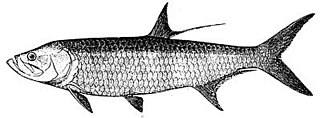
The Elopiformes are the order of ray-finned fish including the tarpons, tenpounders, and ladyfish, as well as a number of extinct types. They have a long fossil record, easily distinguished from other fishes by the presence of an additional set of bones in the throat.

Arowanas are freshwater bony fish of the family Osteoglossidae, also known as bony tongues. In this family of fish, the head is bony and the elongated body is covered by large, heavy scales, with a mosaic pattern of canals. The dorsal and anal fins have soft rays and are long based, while the pectoral and ventral fins are small. The name "bonytongues" is derived from a toothed bone on the floor of the mouth, the "tongue", equipped with teeth that bite against teeth on the roof of the mouth. The arowana is a facultative air breather and can obtain oxygen from air by sucking it into its swim bladder, which is lined with capillaries like lung tissue.
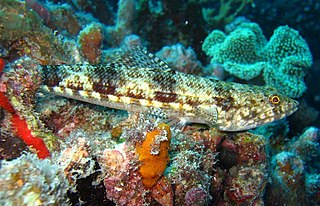
Aulopiformes is a diverse order of marine ray-finned fish consisting of some 15 extant and several prehistoric families with about 45 genera and over 230 species. The common names grinners, lizardfishes and allies, or aulopiforms are sometimes used for this group. The scientific name means "Aulopus-shaped", from Aulopus + the standard fish order suffix "-formes". It ultimately derives from Ancient Greek aulós + Latin forma, the former in reference to the elongated shape of many aulopiforms.

The marine hatchetfishes or deep-sea hatchetfishes as well as the related bottlelights, pearlsides and constellationfishes are small deep-sea ray-finned fish of the stomiiform family Sternoptychidae. They are not closely related to and should not be confused with the freshwater hatchetfishes, which are teleosts in the characiform family Gasteropelecidae. The Sternoptychidae have 10 genera and about 70 species altogether.

Lepomis is a genus of freshwater fish in the sunfish family, Centrarchidae, in the order Perciformes. Perhaps the most recognizable species of this genus is the bluegill.
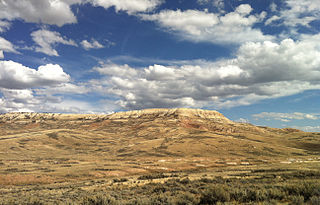
Fossil Butte National Monument is a United States National Monument managed by the National Park Service, located 15 miles (24 km) west of Kemmerer, Wyoming, United States. It centers on an extraordinary assemblage of Eocene Epoch animal and plant fossils associated with Fossil Lake—the smallest lake of the three great lakes which were then present in what are now Wyoming, Utah, and Colorado. The other two lakes were Lake Gosiute and Lake Uinta. Fossil Butte National Monument was established as a national monument on October 23, 1972.
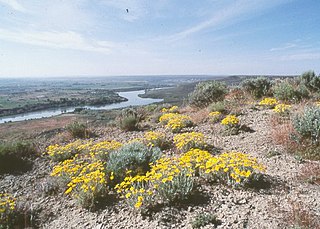
Hagerman Fossil Beds National Monument near Hagerman, Idaho, contains the largest concentration of Hagerman horse fossils in North America. The fossil horses for which the monument is famous have been found in only one locale in the northern portion of the monument called the Hagerman Horse Quarry. The 4,351-acre (17.61 km2) monument is internationally significant because it protects the world's richest known fossil deposits from the late Pliocene epoch, 3.5 million years ago. These plants and animals represent the last glimpse of that time that existed before the Ice Age, and the earliest appearances of modern flora and fauna. This is also significant because the fossils present during this period of the Pliocene represent species which were alive during the early stages in the evolution of man, albeit on a different continent. The fossil beds were designated a National Natural Landmark in 1975.

Sebastes is a genus of fish in the family Sebastidae, most of which have the common name of rockfish. A few are called ocean perch, sea perch or redfish instead. Most of the Sebastes species live in the north Pacific, although two live in the South Pacific/Atlantic and four live in the North Atlantic. The coast off Southern California is the area of highest rockfish diversity, with 56 species living in the Southern California Bight.

Prosopium is a genus of freshwater whitefishes found in North America and parts of eastern Russia. It contains three fairly widespread species: the round whitefish, the pygmy whitefish, and the mountain whitefish. The remaining species, the Bonneville cisco, the Bonneville whitefish, and the Bear Lake whitefish are endemic to Bear Lake.
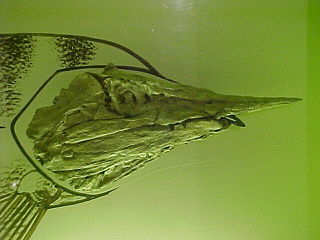
Protosphyraena is a fossil genus of swordfish-like marine fish, that thrived worldwide during the Upper Cretaceous Period (Coniacian-Maastrichtian). Though fossil remains of this taxon have been found in both Europe and Asia, it is perhaps best known from the Smoky Hill Member of the Niobrara Chalk Formation of Kansas. Protosphyraena was a large fish, averaging 2–3 metres in length. Protosphyraena shared the Cretaceous oceans with aquatic reptiles, such as mosasaurs and plesiosaurs, as well as with many other species of extinct predatory fish. The name Protosphyraena is a combination of the Greek word protos ("early") plus Sphyraena, the genus name for barracuda, as paleontologists initially mistook Protosphyraena for an ancestral barracuda. Recent research shows that the genus Protosphyraena is not at all related to the true swordfish-family Xiphiidae, but belongs to the extinct family Pachycormidae.
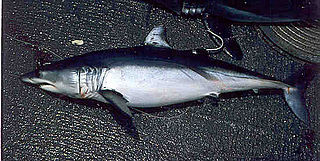
Isurus is a genus of mackerel sharks in the family Lamnidae, commonly known as the mako sharks.

Pangasius is a genus of medium-large to very large shark catfishes native to fresh water in South and Southeast Asia. The term "pangasius" is sometimes used to specifically refer to the commercially important basa fish, P. bocourti.

Zaniolepis is a genus of scorpaeniform fish native to the eastern Pacific Ocean. Z. frenata is known to have been a source of food to the Native American inhabitants of San Nicolas Island off the coast of southern California, United States during the Middle Holocene.

Caranx is a genus of tropical to subtropical marine fishes in the jack family Carangidae, commonly known as jacks, trevallies and kingfishes. They are moderate- to large-sized, deep-bodied fishes which are distinguished from other carangid genera by specific gill raker, fin ray and dentition characteristics. The genus is represented in the Pacific, Indian and Atlantic Oceans, inhabiting both inshore and offshore regions, ranging from estuaries and bays to deep reefs and offshore islands. All species are powerful predators, taking a variety of fish, crustaceans and cephalopods, while they in turn are prey to larger pelagic fishes and sharks. A number of fish in the genus have a reputation as powerful gamefish and are highly sought by anglers. They often make up high amounts of the catch in various fisheries, but are generally considered poor to fair table fishes.
Tarasiiformes is an extinct order of prehistoric ray-finned fish.

Scheenstia is an extinct genus of neopterygian ray-finned fish from the Late Jurassic–Early Cretaceous periods. Fossils have been found in Bavaria, France, and England.
Fish egg fossils are the fossilized remains of fish eggs. Fossil fish eggs have an extensive record going at least as far back as the Devonian and spanning into the Cenozoic era. The eggs of many different fish taxa have contributed to this record, including lobe-finned fish, placoderms, and sharks. Occasionally eggs are preserved still within the mother's body, or associated with fossil embryos. Some fossil eggs possibly laid by fish cannot be confidently distinguished from those laid by amphibians; for example, the ichnogenus Mazonova is known from impressions of eggs which resemble eggs of both fish and amphibians. Paleontologist B.K. Hall has observed that the discovery of fossil fish eggs, embryos and larvae link the sciences of paleontology with evo-devo.

















